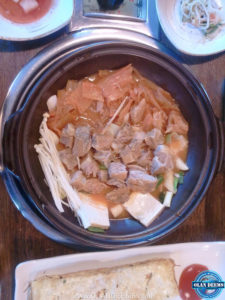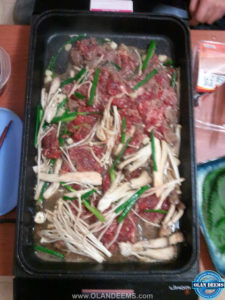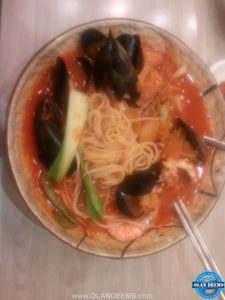Savor the Culinary Wonders: Unforgettable South Korean Dishes (Part 5)
South Korean cuisine is renowned for its bold flavors, diverse ingredients, and unique culinary traditions. From the famous Kimchi to mouth-watering grilled meats and delicious stews, Korean food offers a delightful gastronomic experience that is sure to captivate your taste buds. In this article, we will explore some of the best-tasting South Korean dishes that you should try.
1. Kimchijjigae (김치찌개): A Staple of Korean Comfort Food

Kimchijjigae (김치찌개)
Kimchijjigae, a robust and flavorful Korean stew, is a staple dish that exemplifies the heart and soul of Korean home cooking. Revered for its depth of flavor and comforting qualities, Kimchijjigae centers around kimchi, the beloved fermented vegetable dish that is a cornerstone of Korean cuisine.
At its core, Kimchijjigae combines kimchi with a dynamic mix of ingredients, including scallions, onions, and diced tofu. Proteins such as pork or assorted seafood are also common additions, enriching the stew with flavors and textures that complement the spicy and sour taste of the kimchi. This combination not only enhances the stew’s taste but also adds nutritional value, making it a hearty and satisfying meal.
The base of the stew is typically made from the juice of mature kimchi, which provides a rich and tangy broth. This broth is seasoned to perfection, often with gochujang (Korean chili paste) or doenjang (soybean paste), creating a complex flavor profile that is spicy, savory, and slightly sweet. The result is a pot of stew that warms the body and soothes the soul, making it a popular choice during Korea’s cold winters.
Kimchijjigae is more than just food; it is a versatile dish served on many occasions, from daily meals to social gatherings. It is commonly enjoyed with a bowl of steamed rice and a variety of side dishes, known as banchan. The stew’s versatility and ease of preparation make it a favorite among those looking to enjoy a quick yet delicious meal.
In Korea, Kimchijjigae is not only a culinary delight but also a symbol of resourcefulness and tradition, often made to use up aging kimchi that has become too sour for direct consumption. This practice showcases the Korean ethos of minimizing waste and appreciating the full lifecycle of ingredients.
Kimchijjigae’s enduring popularity reflects its status as a cornerstone of Korean culinary tradition, beloved for its bold flavors and comforting properties. It stands as a testament to the simplicity and richness of Korean cuisine, making it a must-try dish for anyone wanting to experience authentic Korean flavors.
2. Bulgogi (불고기): The Essence of Korean Barbecue
 Bulgogi, a classic Korean dish whose name translates to “fire meat,” embodies the rich flavors and communal spirit of Korean barbecue. This beloved dish is made from thin slices of beef or pork that are marinated and then cooked on a grill or stove-top griddle. The meat, typically sirloin, rib eye, or brisket, is marinated in a mixture of soy sauce, sugar, sesame oil, garlic, and pepper, which enhances its flavor and tenderness.
Bulgogi, a classic Korean dish whose name translates to “fire meat,” embodies the rich flavors and communal spirit of Korean barbecue. This beloved dish is made from thin slices of beef or pork that are marinated and then cooked on a grill or stove-top griddle. The meat, typically sirloin, rib eye, or brisket, is marinated in a mixture of soy sauce, sugar, sesame oil, garlic, and pepper, which enhances its flavor and tenderness.
The marinade is a crucial element of Bulgogi, providing not only moisture but also a sweet and savory flavor that caramelizes upon cooking. This results in a delicately charred exterior and a juicy, flavorful interior that has made Bulgogi famous worldwide. The cooking process, often done at the table over an open flame, adds an interactive element to the dining experience, making Bulgogi not just a meal but a social event.
Bulgogi is typically served with a variety of side dishes, including lettuce leaves for wrapping, sliced garlic, chili peppers, and ssamjang (a thick, spicy paste). Diners can customize each bite by adding different toppings and sauces according to their preferences. This method of eating not only enhances the flavors but also the enjoyment and communal aspect of the meal.
Beyond its delicious taste, Bulgogi is a versatile dish that can be adapted to various meals. It is often featured in Korean stews, noodle dishes, and even as a topping for pizza or in sandwiches, showcasing its wide appeal and adaptability.
Bulgogi’s popularity extends beyond Korea, making it one of the most recognized dishes in Korean cuisine. It appeals to a global palate due to its balance of sweet and savory flavors and its engaging cooking style. Whether enjoyed in a traditional Korean restaurant or at home, Bulgogi provides a taste of Korean culinary excellence and a glimpse into the country’s rich cultural heritage.
3. Jjamppong (짬뽕): A Spicy Delight of Korean Seafood Noodle Soup

Jjamppong (짬뽕)
Jjamppong, a vibrant and spicy Korean noodle soup, captures the essence of Korea’s rich seafood tradition. Known for its fiery broth and hearty ingredients, Jjamppong is a favorite among those who appreciate a robust meal with a kick. This soup features a distinctive red broth, which is both spicy and deeply savory, typically made from a base of seafood or pork.
The foundation of Jjamppong’s broth is flavored with gochugaru (Korean chili powder), which imparts a bright red color and a spicy heat that defines the dish. To this, a medley of vegetables such as onions, garlic, Korean zucchini, carrots, and cabbages are added, creating a flavorful and aromatic base that complements the richness of the seafood or pork.
The seafood components, typically including squid and mussels, are essential to Jjamppong, adding both texture and flavor that elevate the soup. Pork is also commonly included, providing a savory depth that balances the spice. These ingredients are simmered together to meld the flavors, resulting in a soup that is both invigorating and satisfying.
Jjamppong is more than just a dish; it’s a culinary experience that is often enjoyed as a comfort food during cold weather due to its warming properties. It is also popular as a remedy for hangovers, with its spicy broth believed to help revitalize and rejuvenate.
Served with thick, chewy noodles that absorb the flavors of the broth, Jjamppong is a filling meal that delights the palate and fills the stomach. It is often served in large bowls that encourage a communal dining experience, further exemplifying the Korean tradition of sharing meals.
Whether enjoyed in a bustling Korean market or a cozy restaurant, Jjamppong remains a beloved dish among locals and tourists alike, offering a taste of Korean culinary passion through its bold flavors and rich textures.
From the addictive spiciness of Kimchi to the succulent grilled meats and delightful noodle dishes, South Korean cuisine offers an array of mouth-watering flavors that should not be missed. Whether you’re a fan of tangy and spicy or prefer a harmonious blend of sweet and savory, the best-tasting South Korean dishes mentioned above are sure to leave an unforgettable impression. So, don’t miss out on these culinary delights the next time you have the opportunity to explore South Korean cuisine.
[Read more… ]











